
There are many various types of Discus fish all belonging to a geographical location, a class, one of the four major species which include Symphysodon discus, Symphysodon Aequifasciata, and Symphysodon Tarzoo.
Table of Contents
- [1] – Discus Fish Types By Discus Species
- [2] – Discus Fish Types By Their Geographical Origins
- [3] – Discus Fish Types By Discus Classes
- [4] – Discus Fish Types By Discus Country Breeding Quality
- Related Questions
- Conclusion
In order to properly give an answer to the full types of Discus fishes that are available, we need to categorize the Discus types into 4 categories:
- Discus fish types by Discus Species.
- Discus fish types by Discus Classes.
- Discus fish types by Discus Geographical Origins.
- Discus fish types by Discus Country Breeding Quality.
[1] – Discus Fish Types By Discus Species
We will need to look at them in their categories as there are four classifications of discus fishes which are as follows;
Heckle Discus (Symphysodon Discus)
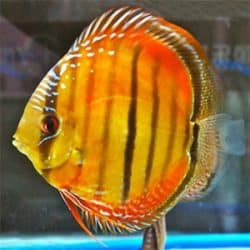
- The Heckel discus can be found in a blackwater confluent known as Rio Negro from which water flows into the Amazon right after Manaus-a city that is popularly known as the ‘fish-collecting centre’.
- Heckle discus is very well known for its outstanding and evident 1st, 5th, and 9th vertical bars. There are light blue stripes that horizontally run through its body. There are a few whose background colours are brown instead of red, but they are very scarce, and that is why they are widely coveted by a lot of breeders and fish collectors.
- One of the most scarce kinds of this discus is ‘Cabeca Azul’. The head of this discus is solid metallic blue down to the back of the gill plate; however, the rest of the body is covered with a red background colour, and blue stripes run through the body.
- The Cabeca Azul can only be found in Rio Unini because the Amazonian Indians who inhabit that region think that it is a gift from gods and therefore consider them as sacred, as a result, it proves difficult to get this Discus.
Willi Schwartz’s Discus (Symphysodon Discus Willi Shwartszi)
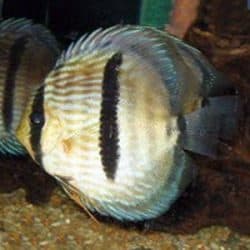
- This discus can be found in Rio Abacaxis, and it looks like the Heckel discus with only a minor unnoticeable difference.
- It has outstanding 1st, 5th, and 9th vertical bars and they have blue stripes that horizontally run through their bodies as well, there are some who state that the blue is a darker shade than in the Heckel discus.
- The major distinguishing factor of this discus from the Heckel Discus is the number of scales on the body – that is, the amount of scales that from behind the gill plate to the lower part of the tail.
- Heckle discus has between 44 and 53 scales while Willishwartz’s discus has between 53 and 59 scales. Willischwartz’s Discus is also pretty rare, that is why they are not usually bred.
Green Discus (Symphysodon Aequifasciata Or Symphysodon Tarzoo)
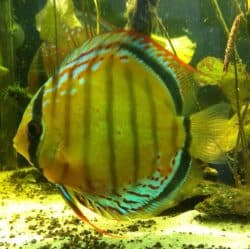
- Green discus is more popular than the wild discus types mentioned above. There are also a lot of variants beginning from the regular Green and going up to the Royal Green.
- Green discus has nine vertical bars that are equal in both size and vividness; the colour of its body ranges from an olive-brown to a warm golden brown. There are blue-green, then green, and then Royal Green stripes that run horizontally through its head.
- The anal and dorsal fins have a seam of black edges; there is also a red stripe around the top the dorsal fin. The eyes of the Green discus is usually red.
Blue Discus (Symphysodon Aequifasciata Haraldi)

- Blue discus is a lot popular among the wild discus types, and they can be found in Rio Purus and Lago Manacapuru, but they can also be found in areas where Green discus are found.
- The body colour of the Blue discus ranges from medium brown to light brown, and the vividness of all nine bars on the body are the same, although, the ones that run over the eye and lower part of the caudal fin are more vivid.
- The forehead down to the gill plates are covered with horizontal blue stripes. The variants of this discus range from the regular Blue discus to the Royal Blue. There are blue and red stripes on the anal and dorsal fins; the ventral fins are dark brown in colour and covered with blue and red stripes.
- The colour of its eyes could either be red or orange. The forehead and abdomen of the Royal Blue variant could have a dark red in the middle of the blue stripes. The blue stripes over the abdomen and shoulder of the Manacapuru Royal Blue discus appear to have a metallic hue and have 3 or 4 times the thickness of regular Blues.
Brown Discus (Symphysodon Aequifasciata Axelrodi)

- This species is the most popular discus fish bred amongst the wild discus, and for that reason, it was being called Common discus. They can be found toward the east from Manaus, through Santarem to Belem; they are part of the reasons why Discus is being bred in tanks.
- In some Amazon River regions, there is Brown Discus that has been noticed to have redder than brown colours, and they are in high demand by people seeking to crossbreed so as to get the Tomato Red striated Discus.
- There are some of these species that have completely brown stripes running through their bodies; Pearl Discus can be gotten from them when they are crossbred with Royal Blue Discus. Examples of completely brown strains include Alenquer Discus, Santarem Discus and Rio Ica Discus.
[2] – Discus Fish Types By Their Geographical Origins
- The three species of Symphysodon above are dispersed over various geographical locations. For instance, Symphysodon Aequifasciatus is mostly found in the Purus arch and moving up to the East Amazon; Symphysodon Tarzoo is found mostly beginning from the Purus arch and moving up to the West Amazon.
- Symphysodon Discus is the one specie that is different from the others in terms of geographic distribution as it can only be found in the lower parts of the Rio Negro, upper Uatamã, Nhamundá, Trombetas and Abacaxis Rivers.
- Discus can also be found in the Nanay River in the far west of the Amazon, which is external to the aboriginal scope. However, the Discus that can be found here are ones that are the natural stemma of the Tefé area.
- At present, there are a substantial amount of Discus fishes that can be found in a lot of fish farms in the southeast area of Asia.
[3] – Discus Fish Types By Discus Classes
There are 14 Discus classes in terms of looks and colours:
Class 1 – The Discus that belongs to this class is the Heckel Discus species.
Class 2 – This class is for the Brown Discus species.
Class 3 – Discus belonging to this class are members of the Blue Discus species.
Class 4 – The Discus fishes in this class are a part of the Green Discus species.
Class 5 – Discus that belong to this class have thick horizontal stripes and vertical stress bars. An example is Turquoise Discus.
Class 6 – Discus in this class have fine stripes and dots that cover their gill plates with at most 14 vertical bars. An example is the Snakeskin Discus.
Class 7 – In this class of Discus, you will find complex-looking patterns. Examples include Pearl Discus, Ring Leopard Discus, and Checkerboard Discus.
Class 8 – Discus belonging to this class are those that have spots on their bodies like Red Spotted Green Discus, Red Leopard Discus, and Leopard Spotted Snakeskin Discus.
Class 9 – This class is for Discus with open and uncommon patterns such as the Albino Snakeskin or Albino Spotted Discus.
Class 10 – This class is for the Blue Discus. It includes Cobalt Discus and Blue Diamond Discus.
Class 11 – Discus that belong to this class is the red Discus. Examples are Eagle Discus and Red Snakeskin.
Class 12 – This is a class for the yellow Discus fish. Examples include Golden, Yellow Crystal, Pigeon blood and Golden Spotted Discus.
Class 13 – Discus that belong to this class is the white Discus. Examples include Snow White and White Pigeon Blood.
Class 14 – This is a class that is open to Discus that doesn’t fit into any of the classes above.
[4] – Discus Fish Types By Discus Country Breeding Quality
Germany – Discus fishes bred in Germany include Marlboro, Blue Diamond Snake Skin and Pigeon Blood Discus.
Thailand – In Thailand, the following types of Discus fishes are being bred; Reds, Pigeon Bloods, Red Eagles, Yellow Pandas and Red Velvets Discus.
China – Most of the Discus fishes bred in China are ones that are derived from the Red Spotted variant.
USA – Among the Discus fishes bred in the United States are the Blue Cobalt, Red Panda, Super Galaxy Turquoise, Yellow Discus and various Pigeon variants Discus.
Vietnam – There are a variety of Discus breeds in Vietnam, like Red White and Blue Diamonds. However, they specialize more in the albino variants such as Albino Golden, Albino Turquoise, Albino Leopard Snakeskin, Albino Snakeskin, and Albino Green Discus.
Malaysia – Discus like Red Marlboro, Golden Leopard, Red Diamond and High Body Leopard Discus are bred in Malaysia.
Related Questions
What Is Pigeon Blood Discus?
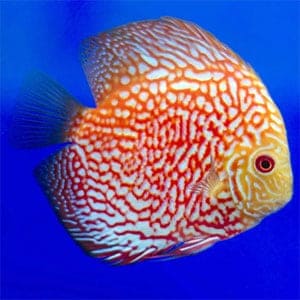
Pigeon Blood Discus is Discus that has a colour base ranging from creamy yellow to orange, it has bright red eyes and trimmed, its eyes are bright red, and it has striations all over its body as well as black specks. Pigeon Blood Discus was created through a mutation in Thailand.
What Are The Most Expensive Discus Fishes?
The most expensive Discus fishes include Red Golden Diamond Discus, Royal F1 Discus, Albino Solid Gold Discus, Golden Checkerboard Pigeon Discus, High Body Cobra Snakeskin Discus, Mystic Red Cover Discus, Flame Turquoise Discus, Red Velvet Discus, Carnation Tiger Turquoise Discus, and Yellow Panda Discus.
What Is A Stendker Discus?
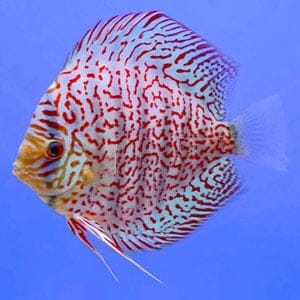
Stendker Discus is a kind of Discus that is gotten from the Stendker Discus breeding farm in Germany, it has a life expectancy of 15 years and reaches its full-grown size in about 2 to 2 & 1/2 years. This discus is comfortable in German tap water, and therefore they are easy to breed.
Conclusion
There are various types of Discus fishes available and more hybrids are being created; each of these hybrids or variants are drawn from Heckel Discus, Green Discus, Blue Discus and Brown Discus which are the four major species of Discus. There are specific countries that breed Discus such as Germany, Vietnam, and China.

It’s hard to search out knowledgeable individuals on this topic, but you sound like you know what you’re speaking about! Thanks
Thank you.
Hi Sir
Which food is best for discus ?
1) beef heart – minced with salmon, spinach and finely minced.
Or
2) dicuss pellets
Also is high body discus more expensive than the round body discus.
Thank you
Rick